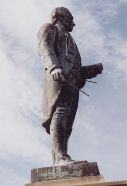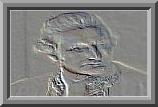Midi Playing:


Under the watchful
eye of Captain James Cook
HM Bark Endeavour returns to her spiritual "home" of Whitby
From an idea in 1967 by the trustees of the Australian National Maritime Museum to build a full-scale museum replica of Captain James Cook's famous Whitby built ship the HM Bark Endeavour as the centre piece of their floating collection.
The plan was to construct an authentic replica of the 18th Century vessel with the support of a number of corporate sponsors. A specially designed shipyard with a gallery overlooking the building dock was built in Freemantle, Western Australia, along with the administrative base.
Work began on building the replica in January 1988 and the keel was laid in October of that year.
The Bond Corporation who had offered to take on the project as a bicentennial gift to the Australian people announced in June 1990 that due to finanical difficulties it could no longer support the project.
Yoshiya Corporation of Japan offered to complete the ship and paid for work to proceed on the vessel, however, in December 1990, Yoshiya too had to withdraw because of its own business problems.
The Bond Corporation then announced the closure of the project but a group of staff and the volunteer guides contined working on a voluntary basis, keeping the shipyard open to the public for the next eight months. During this period alternative avenues of support were explored.
A proposal establishing a charitable trust, the HM Bark Endeavour Foundation, which would complete construction and then commission and operate the vessel.
The National Maritime Museum in Greenwich assisted with the research programme associated with the construction.
The foundation is registered as a charity in Australia and New Zealand. It received continued support from governments and through donations from companies.

Endeavour's visits to Whitby, Yorkshire U.K.
Endeavour's first visit to WhitbyFriday 9th May 1997 was a memory that will last in those who were privileged to see this magnificent ship sail in to Whitby harbour.
Click to enlarge
The surrounding cliff tops, the harbour walls and quayside were filled with tens of thousands of people who had travelled from far and wide to welcome Endeavour and her crew to Whitby, her spiritual home, and the port that the original Bark Endeavour had been built.
As Endeavour approached the harbour mouth she fired her cannon in salute, there was not a dry eye to be seen as this fantastic ship gracefully sailed by thousands of flag waving men, women and children who cheered her to her mooring on Endeavour Wharfe, followed by a flotilla of tiny boats who had sailed out to greet Endeavour.
HM Bark Endeavour leaving Whitby harbour Monday 7 July 2003
A warm sunny day welcomed holidaymakers and Endeavour enthusiasts to Whitby, and preparations for Endeavour's departure later today was in full swing at Endeavour Wharfe, a total of 36,366 people had visited the ship whilst at anchorage.
There was to be more than that by 2100 hours when Endeavour with her three topsails and all fore and aft sails filling with the gentle breeze she slowly and majestically sailed by thousands of cheering well-wishers and a flotilla of craft guiding Endeavour out of the harbour and into the North Sea.
Endeavour has now sailed for homewaters and should reach Sydney, Australia by April 2005 were it will be permantly on display.
17/April/2005
HM Bark Endeavour arrived in Darling Harbour, Sydney.
After undergoing maintenance the Maritime Museum intends to open it to the public, after a quick clean-out. Plans for its long-term future- as a stationary exhibit or as a travelling working ship - have still to be announced.
HhWherever Endeavour is the best wishes of all who have seen her goes with this magnificent ship always
There is a very special bond between Endeavour and the port of Whitby.
Bonnie Horvath, from Brisbane, Australia gives us an insight to life below Endeavours decks.
"Originally the Endeavour only had 2 levels but they added a third deck at the rear of the ship for Captain Cook's voyage due to carrying 94 people on board. Also they carried a milking goat, a cat and 2 greyhound dogs which I think were pets for Mr Josephs Banks as well as more than 12 months supply of food! I'm amazed she didn't sink before she left Whitby!
To give you some idea of what it is like on the middle deck .
At the fore of the ship is the oven used for cooking and storage areas for provisions as well as sleeping quarters for the sailmaker etc. You can stand up in this area but it is very dark and claustrophobic. The doors into the sleeping cabins are only about 5 feet high so you had to bend down to get in there and there is only enough room for a fairly small man to stretch out.
It is dark as night in there even in the daylight and there is no fresh air or natural sunlight. Captain Cook made sure the oven was always lit to dry out the decks above to prevent mould and damp so it must have been hotter than 100 degrees in there when they crossed the Pacific!
In the sailors mess area are tables and their chairs were the sailor's storage chests which were supplied by the British Navy. On the mess ceiling right above the dining tables is where the sailors hung their sleeping hammocks only about 4 inches apart from each other! When they were not sleeping they had to stow them away so they could have room to walk about.
From memory there are only about 8 or 9 of these tables to cater for around 80 men so they must have taken their meals in shifts. Their food was kept in large wooden barrels near the stove. To get to captain cook and the Gentlemen's cabins, which are at the rear of the ship you can only just stand up in the sailor's mess but then you have to crawl on your hands and knees. Here is found the sleeping quarters for some of the Gentlement. You then climb backwards down a set of narrow steps, trying not to hit your head and then you arrive at a kind of hallway which leads to the Captain's mess room. Here there is a hole where light and air can come from the top deck which are covered with flaps of thick glass to keep the area dry if the sea or rain washed over the ship.
Also covering this area is hessian netting to stop you falling down the hole into the lower deck onto the Captain's dining table from the top deck if the glass flaps were raised!
You are able to stand up in the Captain's mess area and walk past a small area that contained Captain Cook's sleeping quarters and washroom and one or two other of the scientists sleeping quarters.
It would have still been difficult to stand up straight in this area though if you were a fall man as I think Captain Cook was.
In the very rear of the ship is Captain Cook's boardroom where they made their world breaking scientific discoveries and I think dissected many fish and animals on a large table.
Off the boardroom is Joseph Banks sleeping quarters and just outside his sleeping quarters in a corner of the boardroom is his small writing desk with his original books in a bookshelf just above.
In this room are many windows which are a Godsend from claustrophobia! Ordinary sailors were not allowed in these areas and were prevented from entering by armed Marines.
Also in the washroom outside Captain Cook's sleeping cabin there was posted one or two armed Marines at all times. Below this area is another deck which is below water level where they kept supplies but is is as dark as a dungeon down there so we couldn't go in."
Thank you Bonnie for such a fantastic description of life below decks
Free JavaScripts
provided
by The
JavaScript Source
Malcolm
Date Last Modified: 25/07/2009





